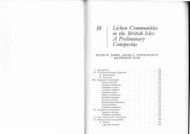You also want an ePaper? Increase the reach of your titles
YUMPU automatically turns print PDFs into web optimized ePapers that Google loves.
settlements, m.-v.acidoph., m.-r.(s.)photoph., a-<br />
to r.nitroph., r.toxitol., above all in the<br />
Parmelietum cap. and (air polluted regions) in<br />
the Buellietum punctatae – (arct-)bor-med –<br />
frequent to very frequent throughout the entire<br />
region, in the south (above all in calcareous<br />
regions) rarer.<br />
LIT: SCHEIDEGGER 1993.<br />
Amygdalaria Norman<br />
(Determined ↑ Lecidea PT 5/PT 6)<br />
Introduction<br />
The Amygdalaria species are crustose lichens<br />
with sunken black, lecideine apothecia, green<br />
algae as symbionts and in addition blue-green<br />
algae in brown cephalodia. Of the up till now,<br />
eight species exclusively living on silicates,<br />
which are very closely related to the Porpidia<br />
genus, three occur in Germany, A. consentiens<br />
(very rare in the Bavarian Alps), A. pelobotryon<br />
(very rare in the Rhön) and A. panaeola, an<br />
arctic-alpine lichen, which is known from the<br />
high Black Forest, Bohemian Forest and from the<br />
Rhön and grows on sites that are relatively long<br />
snow-covered, cool moist on low rocks.<br />
Genus Characteristics<br />
Thallus crustose, clearly developed, <strong>of</strong> flat to<br />
convex areoles, beige, gray, or brown, <strong>of</strong>ten rose<br />
tinted, with brown-red (to gray) cephalodia<br />
between the areoles, sometimes with soralia.<br />
Photobiont Trebouxia-like green algae,<br />
Stigonema in the cephalodia. Ap. sunken,<br />
Aspicilia-like with thalloid margin, rarely sitting<br />
up, black to brown-black, flat to concave,<br />
sometimes with a navel, without definite, rarely<br />
with proper margin. Exc. commonly weakly<br />
developed and then, rarely (not in the species<br />
occurring in Germany) clearly developed, brown.<br />
Hyp. black-brown. Hym. I+ blue, <strong>of</strong><br />
paraphysoid-like, branched and reticulate,<br />
hyphae shrunken toward the ends and at the<br />
septae. Epihym. brown to brown-black. Asci<br />
narrow clavate, <strong>of</strong> the Porpidia-type. Sp. 1celled,<br />
ellipsoidal, when young surrounded by a<br />
slime halo. Pycnosp. bacillar. Ch: <strong>of</strong>ten with<br />
Gyrophoric acid.<br />
Ecology and Distribution <strong>of</strong> the Species<br />
Amygdalaria panaeola (Ach.) Hertel & Brodo<br />
(Lecidea p. (Ach.) Ach.<br />
In high montane to alpine, rarely montane places<br />
on moist neutral to basic silicate rock (mineralrich<br />
Gneiss, Slate, basalt etc.) on high<br />
precipitation, longtime snow covered, cool,<br />
rather light-rich , usually away from the sun<br />
habitats, e.g. in boulder slopes, maritime<br />
boulders, single boulders in thin turfs,<br />
subneutroph.-m.acidoph., m.-r.photoph.,<br />
anitroph., e.g. in the Porpidion tub. – arct-mieurh’mo/alp<br />
– (v.)rare, because <strong>of</strong> removal <strong>of</strong> stones<br />
(2); süSch, Vog, He (Meissner, Rhön, je lx),<br />
BayW<br />
Amygdalaria pelobotryon (Wahlenb.) Norman<br />
(Aspicilia p. (Wahlenb.) Th.Fr.)<br />
Rather like A. panaeola – arct-bor(-mieur-h’mo)<br />
– very rare; Rhön (1x)<br />
LIT.: BRODO & HERTEL 1987<br />
Anaptychia Körber<br />
(Determined ↑ Physcia)<br />
Introduction<br />
The perhaps 10 species <strong>of</strong> the genus are gray or<br />
brown, narrow lobed fruticose and foliose lichens<br />
with flat lecanorine apothecia with dark brown to<br />
black disk and greenish to brown-black twocelled<br />
spores. In a few species – as in the case <strong>of</strong><br />
A. ciliaris – the ends <strong>of</strong> the thallus lobes are<br />
conspicuously bristly ciliate.<br />
Only A. ciliaris has been recorded in the<br />
region. It lives on mineral-rich, <strong>of</strong>ten slightly<br />
dust impregnated bark <strong>of</strong> deciduous trees on<br />
light-rich habitats, <strong>of</strong>ten on avenue trees. The<br />
lichen is as a result <strong>of</strong> developing air pollution<br />
strongly in decline. Formerly distributed over<br />
the entire <strong>Baden</strong>-<strong>Württemberg</strong> region, it is today<br />
disappearing in the north and northwest. The<br />
European area stretches from the Mediterranean<br />
area up to southern Scandinavia.<br />
Genus Characteristics<br />
Thallus fruticose, segments branched,<br />
dorsiventrally flattened, upper side gray to<br />
76





